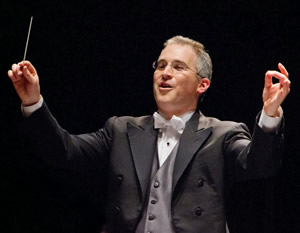Two richly orchestrated and well played English works, and some highly impressive keyboard fireworks from the 19th century French piano repertoire, gave the audience at Meymandi Concert Hall an evening of stunning music in the latest program of the North Carolina Symphony‘s 2010-11 season.
Japanese pianist Noriko Ogawa was the featured soloist in Camille Saint-Saens’ Piano Concerto No. 5 in F, Op. 103, called the “Egyptian,” and someone familiar with this concerto only through recordings will discover so much more watching it played in concert. The composer’s second piano concerto might be better known (it was part of an NCS concert in early February), but the fifth concerto is a crowd-pleaser of the first rank, and both the symphony orchestra and especially Ms. Ogawa were completely up to the demands of the score.
Saint-Saëns composed the piece while in Egypt in 1896, and certain passages at least hint at Middle Eastern musical sounds, but the piece actually seems more an internationally-flavored work — perhaps even a kind of “world music” well before that phrase came into vogue. More than 20 years elapsed between Saint-Saens’ fourth and fifth concertos, but as commentators point out, he had lost none of his compositional skill or virtuosity. At its most dramatic, this is a no-holds-barred, take-no-prisoners composition, with a middle movement that is one of the most interesting “andantes” ever written — if one assumes that an andante is a slower, perhaps more sedate, interlude between two faster, livelier outer movements.
This movement starts out with both drama and tension, including a long descending run, sweeping chords and intricate fingering — not your usual andante. Saint-Saëns himself said part of the second movement was influenced by a Nubian melody he heard sung by Nile boatmen. But the movement also includes sections that seem influenced by Spanish music (did anyone else think that some passages could have been written by someone like de Falla?) and by East Asian melodies, especially when Ms. Ogawa’s right hand was at the uppermost end of the keyboard, playing nervous, repetitive figures joined by a gong. But what sets this movement apart are two instances of unusual composition in which identical figures are played in both hands perhaps two octaves apart. The right hand phrases add an almost ghostly overtone to the music.
The opening allegro animato movement was highlighted by fine string accompaniment. Ms. Ogawa’s powerful chords at both ends of the keyboard, along with long runs up and down, were a good indicator of the strength and clarity of tone she possessed to carry this piece off successfully. The start of the finale: allegro vivace movement marked a musical return to more French sensibilities, with themes almost skipping along the keyboard, but the movement also included huge clots of chords (Lisztian, or maybe even Russian, considering the international nature of the piece) with a truly gigantic finish. Ms. Ogawa started at the bottom of the keyboard and seemed to include just about all 88 keys at some point in a rapidly played, yet slowly ascending, passage of grand chords.
After finishing the piece to sustained applause, Ms. Ogawa described her experience in the recent Japanese earthquake, and she provided a brief encore, “A Particle of Water.” This contemporary piece by Yoshihiro Kanno includes bell-like sounds from metal chopsticks suspended from a stand next to the music and had a more Western style of composition. The piece was a fitting musical conclusion to her appearance with the symphony.
English music began and ended the concert, and the symphony players under Grant Llewellyn gave an assured, skillful reading of George Butterworth’s “A Shropshire Lad” and Ralph Vaughan Williams’ Symphony No. 2 in G, called “A London Symphony.”
“A Shropshire Lad,” an orchestral rhapsody based on part of A.E. Houseman’s collection of poetry, conveys Butterworth’s wistfulness, even melancholy, over an England of the past. Especially prominent were the second violins and cellos, and winds and brass also added luster to the music.
Vaughan Williams’ “London” symphony is a musical picture of the great metropolis, with the softest strings opening the lento-allegro risoluto movement to signify dawn over the Thames, and a harp playing two of the four-note figures from the Big Ben clock tower chime. A dramatic shift in the music toward a sense of urgency conveys the city’s awakening, marked by some martial music and a full range of percussion (timpani, bass drum, snare drums and cymbals) and quite modern-sounding descending figures.
The second lento movement is more somber, often in minor key, although a portion of the movement builds in intensity, recalling the buildup in his “Thomas Tallis” fantasy. This movement also was marked by an especially nice solo viola line. The third scherzo movement is quite lively, resembling at times what could pass for background music to a filmed newsreel or documentary, while the fourth andante con moto movement opens in stately manner, and the harp returns to toll three-quarters past the hour. The music de-intensifies, calming down to signify night settling over the Thames and the city. The solo viola line in the second movement was matched by a lovely “Lark Ascending”-type first violin solo near the end of the final movement.
What was most striking about these pieces is how well the orchestra sounded in the slowest, quietest moments, especially the strings. Llewellyn has crafted a string section that can whisper with the best, bringing a fine sense of delicacy without any thinness to bear on the most pianissimo of passages. Also, the NCS reeds, brass and other winds provided fine ensemble and solo voices. Both pieces were long on introspection and short on splashy, with post-Victorian Romanticism that does not veer into schmaltz and the orchestra was in top form throughout.











